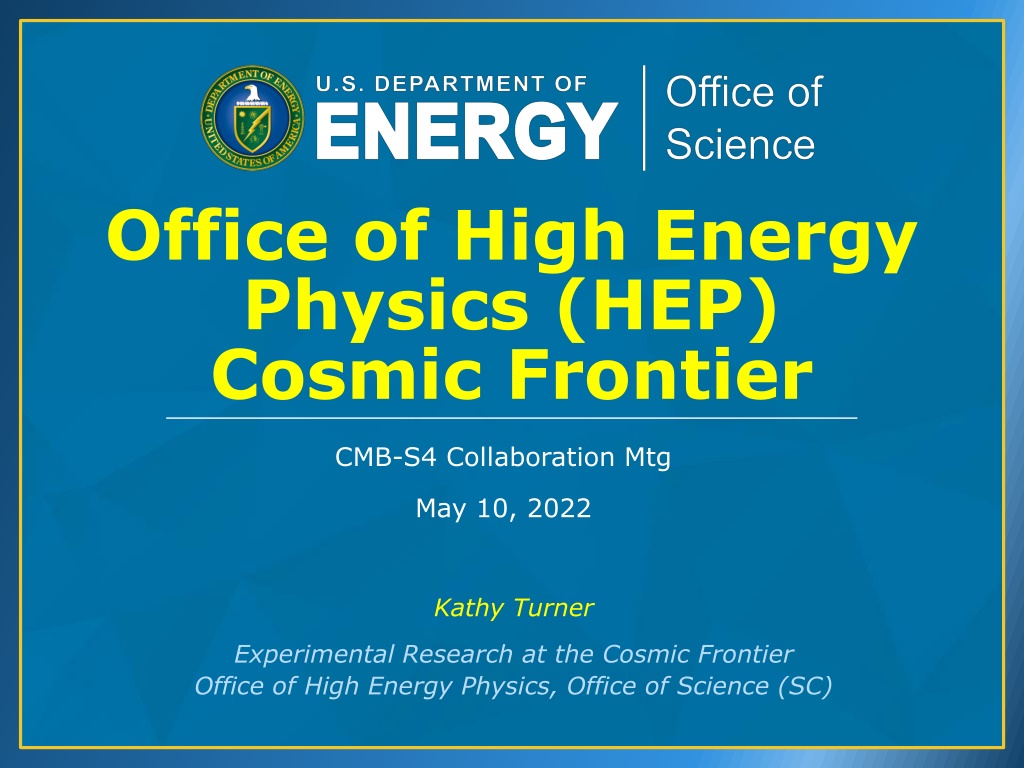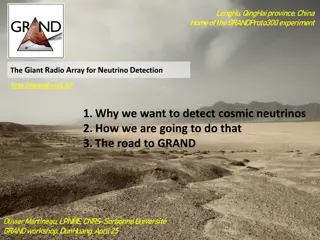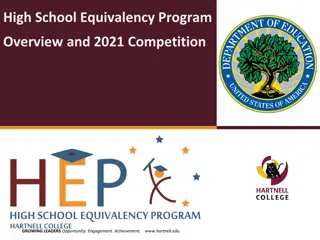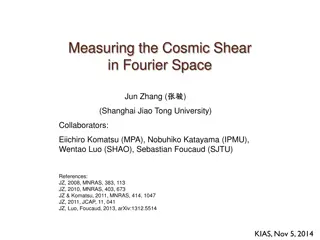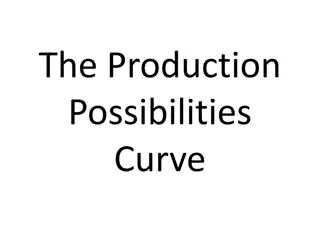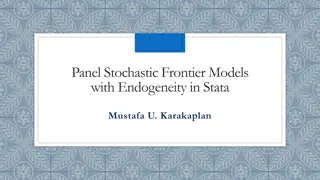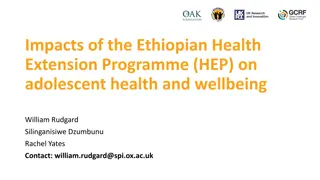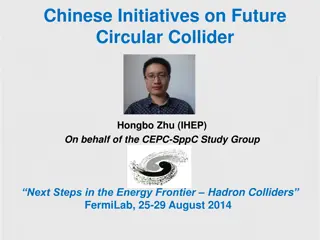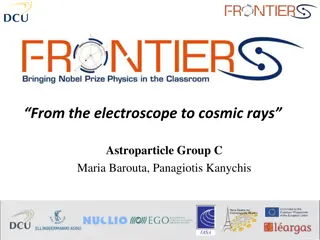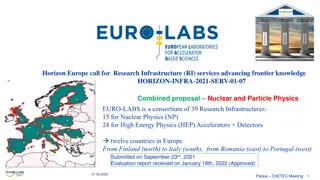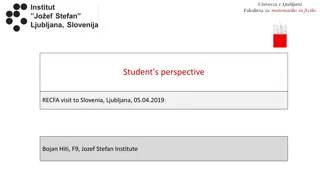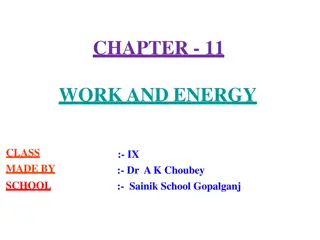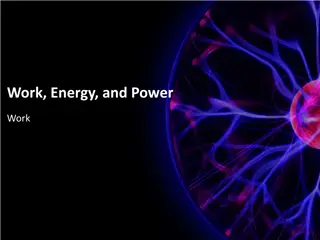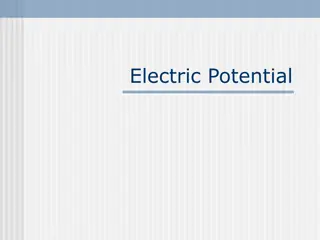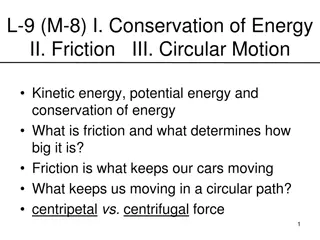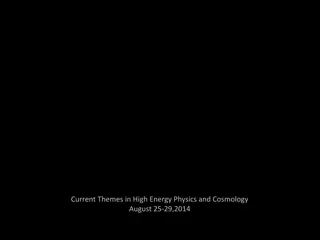Understanding the Office of High Energy Physics (HEP) Cosmic Frontier
The Office of High Energy Physics (HEP) at the Department of Energy (DOE) plays a vital role in advancing our understanding of the universe at its most fundamental level. HEP's mission includes exploring the elementary constituents of matter and energy, investigating their interactions, and delving into the nature of space and time. This summary provides insights into HEP's program layout, its focus on advancing at three frontiers, and the guidance it receives from advisory panels. Collaboration and research endeavors within the Cosmic Frontier are highlighted, emphasizing the importance of cosmic discovery in areas such as dark energy, dark matter, and neutrino properties.
Download Presentation

Please find below an Image/Link to download the presentation.
The content on the website is provided AS IS for your information and personal use only. It may not be sold, licensed, or shared on other websites without obtaining consent from the author. Download presentation by click this link. If you encounter any issues during the download, it is possible that the publisher has removed the file from their server.
E N D
Presentation Transcript
Office of High Energy Physics (HEP) Cosmic Frontier CMB-S4 Collaboration Mtg May 10, 2022 Kathy Turner Experimental Research at the Cosmic Frontier Office of High Energy Physics, Office of Science (SC)
The Office of High Energy Physics (HEP) Program Mission DOE is a mission-oriented agency mission includes maintaining a vibrant U.S. effort in science and engineering as a cornerstone of our economic prosperity with clear leadership in strategic areas. HEP s mission is to understand the universe at the most fundamental level: Discover the elementary constituents of matter and energy Probe the interactions between them Explore the basic nature of space and time Scientific Areas are intertwined: High Energy/Particle Physics, Cosmology, Astrophysics, and Astronomy. DOE supports ~ 85% of the U.S. HEP effort (in $) at Universities + National Labs DOE-HEP-Cosmic to CMB-S4 Collab mtg 2
HEP Program Layout HEP is carried out along 3 Frontiers: Advancements at all 3 frontiers are needed to achieve the long-term goals of the field. HEP is primarily a Particle Accelerator based program: Energy & Intensity Frontiers Cosmic Frontier is an increasingly important area for discovery. Experiments use naturally occurring data to provide additional input to the Standard Model picture: Cosmic Acceleration (Dark Energy, Inflation), search for Dark Matter particles, Neutrino properties, New Physics (e.g. relic particles, etc) Crosscutting HEP subprograms: Theoretical research, High Performance Computing & Computational HEP, Advanced Detector R&D, Quantum Information Science (QIS). DOE-HEP-Cosmic to CMB-S4 Collab mtg 3
HEP Program Guidance FACA panels & subpanels provide official advice: High Energy Physics Advisory Panel (HEPAP) Advises DOE & NSF: Provides the primary advice for the HEP program Subpanels: The Particle Physics Project Prioritization Panel ( P5 ) provides the Strategic Plan for HEP Astronomy and Astrophysics Advisory Committee (AAAC) Advises DOE, NASA, & NSF on issues of overlap, mutual interest and concern Subpanels: CMB-S4 Concept Definition Taskforce (2017), Gemini-Blanco-SOAR Telescopes roles (2019) Advice Also Provided by: National Academy of Sciences (NAS) Decadal Surveys in Astronomy & Astrophysics (Astro2020) Decadal Survey of Elementary Particle Physics being planned Board on Physics & Astronomy (BPA), Committee on Astronomy & Astrophysics (CAA) Other Input & Coordination Community studies & input, e.g. Snowmass, APS/DPF Basic Research Needs (BRN) studies to start development of new HEP initiatives DOE-HEP-Cosmic to CMB-S4 Collab mtg 4
Astro2020 Pathways to Discovery in Astronomy and Astrophysics for the 2020s National Academies Decadal Survey of Astronomy and Astrophysics released Nov. 4, 2021. Charged & supported by DOE, NSF and NASA DOE appreciates all the hard work the community and the National Academies have done in carrying out the study and providing the report. Astro2020 recommended: DOE/NSF partnership on CMB-S4 Efforts on diversity, equity, inclusion, demographics, data, etc. (joint with NSF & NASA) We have started internal discussions on the recommendations; will engage with NASA and NSF regarding joint recommendations DOE-HEP-Cosmic to CMB-S4 Collab mtg 5
Cosmic Frontier Experimental Research Program Cosmic Frontier researchers use naturally occurring cosmic particles and phenomena to reveal the nature of dark energy and dark matter, comprising ~95% of the universe, understand the cosmic acceleration caused by dark energy and inflation, infer neutrino properties, and explore the unknown. Carrying out program with specific projects recommended by P5: Research? Fron ers? Par cle? Physics? Science? Drivers? Cosmic Acceleration: Study the nature of Dark Energy using imaging & spectroscopic surveys Use the CMB to study the Inflation Dark Matter Direct Detection searches for Dark Matter particles using a variety of methods and technologies Neutrinos Constrain properties using dark energy & CMB measurements Always interested in Exploring the Unknown and New Physics! DOE-HEP-Cosmic to CMB-S4 Collab mtg 6 2
Cosmic Frontier Program Planning & Execution Astro2010 recommended DOE/NSF partnership on LSST (Rubin) P5 (2014) recommended Cosmic Frontier science & project priorities in Dark Energy, Dark Matter (direct detection) & CMB Dark Energy: build LSST (Rubin) & DESI Dark Matter: suite of generation 2 direct detection experiments ADMX-G2, LZ, SuperCDMS SNOLAB CMB: support as part of the core program within multi-agency context; carry out multi-agency CMB-S4 project later in the decade Maintain a portfolio of small projects: e.g. we are carrying out ADMX-G2, SPT-3G, Dark Matter New Initiatives Notes: Most Experiments are done in partnership with NSF-PHY, NSF-AST, NSF-OPP, NASA, and/or International agencies/institutions. Significant contributions & support from other HEP areas, e.g. Theory, Advanced Detector Development, Computational HEP, QIS, AI/ML Contributions from other SC areas ASCR Supercomputing resources 7 DOE-HEP-Cosmic to CMB-S4 Collab mtg 2
Cosmic Frontier Cosmic Acceleration Cosmic Acceleration: Research? Fron ers? Par cle? Physics? Science? Drivers? Imaging & Spectroscopic surveys to determine the nature of Dark Energy Stage 3 o extended Baryon Oscillation Spectroscopic Survey (eBOSS), Dark Energy Survey (DES) Stage 4 o Dark Energy Spectroscopic Instrument (DESI) o Vera C. Rubin Observatory, w/DOE s LSST CameraMIE project, Rubin Facility Operations, & the Dark Energy Science Collaboration (DESC) Study the Inflationary era using its imprint on the cosmic microwave background (CMB) at energies near the Planck scale (with NSF) o South Pole Telescope 3rd Generation (SPT-3G) o CMB-stage 4 (CMB-S4) 8 DOE-HEP-Cosmic to CMB-S4 Collab mtg 2
Astro2020 Science Theme: New Messengers and New Physics Scientific questions associated with inquiries ranging from astronomical constraints on the nature of dark matter and dark energy, to the new astrophysics enabled by combined observations with particles, neutrinos, gravitational waves, and light. The needed capabilities include: Facilities to discover and characterize the brightness and spectra of transient sources as they appear and fade away Ground-based ELTs to see light coincident with mergers A next-generation radio observatory to detect the relativistic jets produced by neutron stars & black holes Next generation CMB telescopes to search for the polarization produced by gravitational waves in the infant universe Upgrades to current ground-based gravitational wave detectors, and development of next generation technologies Improvements in the sensitivity and angular resolution of high energy neutrino observatories Astro2020 recommended DOE/NSF partnership on CMB-S4 (p. 7-26) NSF & DOE should jointly pursue the design & implementation of the next generation ground-based cosmic microwave background experiment. HEP is having internal discussions & will talk with NSF at the appropriate time. DOE-HEP-Cosmic to CMB-S4 Collab mtg 9
Astro2020 Report: Realizing the Opportunities CMB-S4 builds on the foundation of decades of CMB measurements to take a major leap, pushing CMB science to the next level, with scientific goals: B-mode CMB polarization signatures of primordial gravitational waves and inflation Maps 50% sky, every other day from 0.1-1 cm with unprecedented sensitivity Broad science including systematic time domain science Key Attributes Balanced program between DOE (60%) and NSF (40%) for all phases Brings wide range of technical & scientific expertise from community & national labs Total design, development and construction cost: $660M First observations could begin by 2030 "An important requirement for our strong endorsement is that the project broadly engage astronomers beyond the traditional CMB community. CMB-S4 will produce data sets of unprecedented sensitivity, cadence and spectral coverage that will advance general astrophysics and open discovery space opportunities for diverse scientific communities. Previous CMB experiments have not had the charge or funding to make data rapidly available and generally usable. Because of its great potential to advance general astrophysics and open discovery space, it is essential that CMB-S4 produce transient alerts, as well as calibrated maps in all bands and on all angular scales that are openly usable and accessible on as rapid a cadence as practical DOE-HEP-Cosmic to CMB-S4 Collab mtg 10
CMB-S4 Planning & Status 2014 HEPAP/P5 strategic plan recommended CMB-S4 as a joint DOE/NSF project 2016-2017 AAAC subpanel: CMB-S4 Concept Definition Taskforce study 2019 DOE approved CD-0; HEP Cosmic Frontier s next Flagship Project 2020 LBNL chosen as DOE s lead lab FY2021 - Congress approved as an MIE project start Goal: cross critical science thresholds, including definitive tests of Inflation In planning phase as a joint DOE & NSF project: 21 telescopes, in 2 aperture scales, at 2 sites: 2 large aperture (6m) in Chile o Deep & wide Neff & Legacy Survey ~60% of sky 1 large (5m), 18 small (0.5m) at South Pole o Ultra-deep survey 3% of sky + delensing Total 500,000 cryogenic sensors, superconducting readout; scale up of over x10 from all stage 3. Science Stage 2 0.1 Stage 3 Stage 4 Top Level goal for CMB-S4 Detect/rule out classes of inflationary models Detect/rule out light relic particles w/ spin 3s detection Deployed on multiple telescopes 2 to 1 angular scales Inflation r 0.01 0.001 s(Neff) 0.14 0.06 0.03 s(Mn) # detectors Sensitivity (mK-2) 0.15eV ~1000 0.06eV ~10,000 ~500,000 0.02eV 105 108 108 Collaboration > 300 members! DOE-HEP-Cosmic to CMB-S4 Collab mtg 11
CMB-S4 Planning & Status Short-term funding gap is limiting progress, particularly for Detectors, Readout, and Modules which require continued R&D before production can start Strong recommendation from Astro2020 for DOE and NSF to partner in CMB-S4 development. Status and plans updated and presented at the Director s Review November 2021; DOE Office of Project Assessment status review in February 2022 Readout module Module Assembly Horn Array Interface Wafers Caption goes here Detector wafer
DOEs SC and HEP DEI efforts The DOE Office of Science (SC) is fully committed to fostering safe, diverse, equitable, and inclusive work, research, and funding environments that value mutual respect and personal integrity. https://www.energy.gov/science/diversity-equity-inclusion DOE SC-wide effort to implement DEI 2019 Report Recommendations. See report to Nov. 2021 HEPAP by Dr. Julie Carruthers, head of DOE SC Office of Diversity, Inclusion & Research Integrity. https://science.osti.gov/-/media/hep/hepap/pdf/202111/SC_DEI_Initiatives- Carruthers_HEPAP_202111.pdf SC has added language to its Funding Opportunity Announcement s (FOA) to remind the community of prohibition of harassment & discrimination by awardees and recipient institutions. SC now includes diversity-promoting program policy factors in all of its FOA s which allow the selection official to make award decisions based on other factors when all other things such as merit are considered equal, including e.g. promoting diversity of PI s, institutions, etc. DOE-HEP-Cosmic to CMB-S4 Collab mtg 13
DOEs SC and HEP Funding Opportunities https://science.osti.gov/Funding-Opportunities HEP Research Opportunities FOA (our primary research FOA) for Six HEP research subprograms Energy, Intensity, and Cosmic Frontiers HEP Theory, Accelerator R&D, and Detector R&D Letter of Intent (strongly encouraged) due ~ August Final Proposal deadline ~ October Review and Selection processes: Winter/Spring Please read the FOA carefully and comply with all requirements! There is an associated FAQ. See https://science.osti.gov/hep/Funding-Opportunities FOA # 2546 FY2022 added an appendix on the PI s Recruitment and Mentoring Plan: Included in research efforts is training of junior scientists (students & postdocs) to enable them successfully complete their research and move to next career step. Further, we want to broaden and diversify the HEP research community and increase opportunities for everyone to contribute. A new merit criterion was added for proposal evaluation: Quality and Efficacy of Recruitment and Mentoring Plan DOE-HEP-Cosmic to CMB-S4 Collab mtg 14
DOEs SC and HEP Funding Opportunities https://science.osti.gov/Funding-Opportunities Data Management Plan (DMP) All Research proposals submitted to DOE SC must have a DMP Data management involves all stages of the digital data life cycle: capture, analysis, sharing, and preservation. The SC Digital Data Management Statement focuses on sharing and preserving digital research data. SCEarly Career Program (PI s within 10 yrs of PhD and awards are for 5 years) continues to promote diversity of PI s and Institutions. Program supports over 80 PI s/year. The recently-closed 2022 (FOA) strengthened review criteria consideration of promotion of diversity of PI s and Institutions. Specific opportunities in: US-Japan HEP SciDAC in HEP HEP has graduate student traineeships in Instrumentation, Accelerator R&D and Computational HEP, e.g. see https://science.osti.gov/-/media/grants/pdf/foas/2021/SC_FOA_0002496.pdf DOE-HEP-Cosmic to CMB-S4 Collab mtg 15
DOE Funding Opportunities WDTS & SC Workforce Development (WDTS) programs: https://science.osti.gov/wdts Office of Science Graduate Student Research fellowships (SCSGR) Supports grad student research at a DOE lab, 3 to 12 months Two calls per year, usually Feb/Aug Applications typically due May/Nov for following Fall or Summer start Science Undergraduate Laboratory Internships (SULI) Supports undergraduate research at a DOE lab, 10 to 16 weeks Three calls per year, for following Spring/Summer/Fall terms Visiting Faculty Program Summer research support for faculty/students from historically underrepresented institutions One call per year, usually in Oct. Applications due in Jan. A FOA is in progress for SC-wide Reaching a New Energy Sciences Workforce (RENEW) program to support undergrad and graduate student fellowships targeted at MSI/URG Office of Science programs: Early Career Research: https://science.osti.gov/early-career SC Open Call [DE-FOA-0002414] new version posted annually HEP uses this primarily for conferences, supplements, experimental operations, and emergencies (e.g. equipment failure). 16 DOE-HEP-Cosmic to CMB-S4 Collab mtg
HEP PI mtg, Code of Conduct, Reviews HEPholds an annual PI meeting geared towards university PI s, and specifically to help junior PI s to navigate the program and have direct contact with DOE program managers. - Talks by HEP staff on overall program, budget, new initiatives, DEI, funding opportunities, and details of each area, e.g. Cosmic Frontier. - We encourage you to read over these talks and contact the relevant program manager regarding program details and opportunities. - For 2021 see https://www.orau.gov/heppi2021 -- go to agenda & linked talks Most of the HEP Cosmic Frontier projects and collaborations have developed Codes-of-Conduct. This is a promising practice within the community HEP specifically considers diversity when setting up review panels for proposals as well as projects, experimental operations and facilities. DOE-HEP-Cosmic to CMB-S4 Collab mtg 17
Strategic Planning Timeline HEP community-wide Snowmass study process organized by the Division of Particles and Fields (DPF) of the American Physical Society (APS) has restarted (https://snowmass21.org/start) Paused due to the COVID; resumed full activities as of September 2021 Community Summer Study will take place July 17 27, 2022 at UW-Seattle. Full Snowmass reports will be available by the end of October 2022 New National Academy of Sciences (NAS) Elementary Particle Physics (EPP) Decadal Survey will run concurrently with and complement the Snowmass process Next P5 process to begin after Snowmass and NAS Decadal Survey, circa late 2022: P5 report by May 2023 will inform FY 2024 Congressional actions & FY 2025 U.S. budget formulation 2020 2021 2022 2023 Process Description J F M A M J J A S O N D J F M A M J J A S O N D J F M A M J J A S O N D J F M A M J NSB HL-LHC MREFC Decision European Strategy Process NAS Astro2020 Survey APS/DPF Snowmass Process NAS EPP Decadal Survey P5 Process Report Writing Community Input Phase J F M A M J J A S O N D J F M A M J J A S O N D J F M A M J J A S O N D J F M A M J 2020 2021 2022 2023 DOE-HEP-Cosmic to CMB-S4 Collab mtg 18
Summary HEP continues to carry out the 2014 P5 strategic plan; Strong support from the scientific community and the Hill Cosmic Frontier continues to produce excellent, world-leading science results DES completing data analyses DESI has started it science survey operations (May 2021) LSST Camera complete, Commissioning ongoing Rubin Observatory Facility Ops planning to be ready for data in 2024. DESC planning dark energy studies CMB-S4 LBNL selected as lead DOE lab; Approved as a fabrication project for DOE in the FY2021 budget; working towards planning for CD-1 and beyond. Recommendation by Astro2020 Future Planning Astro2020, Snowmass P5 DOE-HEP-Cosmic to CMB-S4 Collab mtg 19
